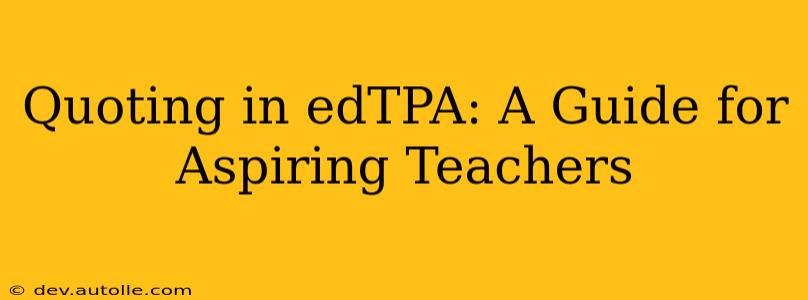The edTPA (Educator Effectiveness Assessment) is a significant hurdle for aspiring teachers. Successfully navigating its requirements, particularly the accurate and effective use of quoting, is crucial for a high score. This guide will walk you through the intricacies of quoting in your edTPA, ensuring you present your evidence clearly and professionally. We'll cover best practices, common pitfalls, and answer frequently asked questions to help you confidently demonstrate your teaching expertise.
Why is Quoting Important in the edTPA?
Quoting in your edTPA isn't just about avoiding plagiarism; it's about providing strong, verifiable evidence to support your claims. The assessors need to see exactly what happened in your classroom and how you responded. Accurate quotes from your students, lesson plans, or other relevant documents provide concrete evidence of your teaching practices and their effectiveness. They allow the assessors to judge the quality of your instruction and your analysis of student work.
How to Properly Quote in Your edTPA
Effective quoting involves more than simply placing quotation marks around a passage. Here’s a breakdown of best practices:
- Choose Relevant Quotes: Select quotes that directly support your claims and analysis. Avoid lengthy, irrelevant quotes that clutter your submission.
- Use Short, Punchy Quotes: Keep quotes concise and to the point. Long quotes can be distracting and make your writing less impactful.
- Integrate Quotes Smoothly: Don't just drop quotes into your writing. Introduce them smoothly with context and explain their significance. Use signal phrases like "Student X stated," or "As evidenced by the following quote..."
- Use Ellipses and Brackets Appropriately: If you omit words from a quote, use ellipses (...) to indicate the omission. If you need to add clarifying words or change capitalization, enclose them in brackets [ ].
- Cite Your Sources: Always cite the source of your quote. This might involve referencing a specific student's work, a lesson plan document, or other relevant materials. Maintain consistency in your citation style throughout the portfolio.
- Avoid Over-Quoting: While evidence is key, relying solely on quotes without your own analysis weakens your argument. Analyze the quotes and explain why they are important.
Common Mistakes to Avoid When Quoting
- Quoting without context: A quote without explanation is meaningless. Always provide sufficient background information to help the reader understand its relevance.
- Overusing direct quotes: While direct quotes are important, relying on them exclusively can make your writing sound disjointed and lack your own insightful analysis. Paraphrasing and summarizing are also valuable skills to showcase.
- Inconsistent citation: Maintain a consistent citation style throughout your entire edTPA submission. Inconsistency suggests a lack of attention to detail.
- Incorrect use of ellipses and brackets: Misusing ellipses or brackets can alter the meaning of the original text and undermine the credibility of your work.
- Plagiarism: Always properly cite your sources and avoid representing others' work as your own.
What if a Student's Quote Contains Grammatical Errors?
Preserve the student's original language, including any grammatical errors. Use brackets to add clarifying information, such as [sic] after the error to indicate that the error appeared in the original text. This demonstrates your awareness of the need to present accurate, unedited student work.
How Long Should My Quotes Be?
There's no magic number, but strive for brevity. Aim for quotes that are short enough to be easily digestible but long enough to provide meaningful context. If a quote is excessively long, consider paraphrasing or summarizing it.
What Citation Style Should I Use for my edTPA?
While the edTPA doesn't specify a particular citation style, maintain consistency throughout your document. A simple in-text citation system, clearly identifying the source of each quote, is usually sufficient. Avoid overly complex citation systems that might distract from your analysis.
Conclusion
Mastering the art of quoting in your edTPA is essential for demonstrating your teaching abilities effectively. By following these guidelines and avoiding common pitfalls, you'll significantly strengthen your portfolio and increase your chances of success. Remember, the goal isn't just to quote; it's to use quotes strategically to support your arguments and showcase your insightful reflection on your teaching practice. Good luck!

